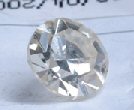Thomson McKinnon Diamond Investment Trust, the Infamous Forerunner
August 22, 12
 |
At launch, shares in the Trust traded at $994. As investors got wind of the quickly declining diamond prices, the fund's shares lost favor, dropping to $565 seven months later.
A year earlier, in 1980, a D / FL 1 carat diamonds sold for $50,000. By 1985, they sold for $8,000-$12,000 among wholesalers in what is considered until this day one of the worse crashes in diamond prices.
According to Barron's Finance & Investment Dictionary, the Diamond Investment Trusts invested in high quality diamonds. Barron's warned, "Shares in these trusts do not trade actively and are therefore difficult to sell if diamond prices fall," as they did soon after the first trust was set up.
Loose polished diamond traders still view with near horror the steep drop in diamond prices in the 1980s, some of them lost a considerable amount of money when the value of their expensively bought inventory lost a large chunk of its value. As the example of one-carat diamonds mentioned above shows, in some cases the value of inventories were slashed by as much as 80 percent. The result was a large number of bankruptcies and the fall of a number of very large companies, dragging the industry to a major economic catastrophe.
Though launched after prices started to decline (but before the quick tumble), the Thomson McKinnon Diamond Investment Trust is still associated with the price decline in the memories of many in the wholesale sector and therefore many of them oppose the formation of diamond funds today.
Is the Thomson McKinnon Diamond Investment Trust the ultimate warning against investing in diamonds? Not necessarily. First, the timing of the trust was horrible. While diamond prices are currently softening, the declines are nowhere near the free fall of the mid-80s. In addition, the Trust was a futures market. None of the proposed investment opportunities today is a future market, ostensibly creating a lesser impact on long-term pricing.
Finally, Thomson McKinnon Inc. was probably suffering from a number of problems unrelated to diamonds. Though it tried to ride the tidal wave of escalating diamond prices, it did not recognize the change in direction and hold off issuing the shares.